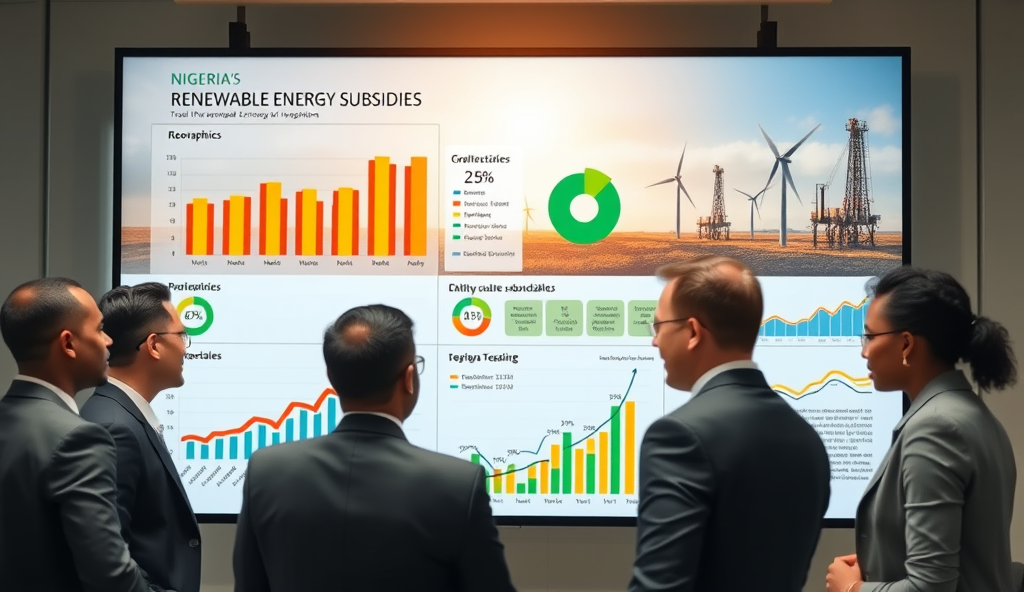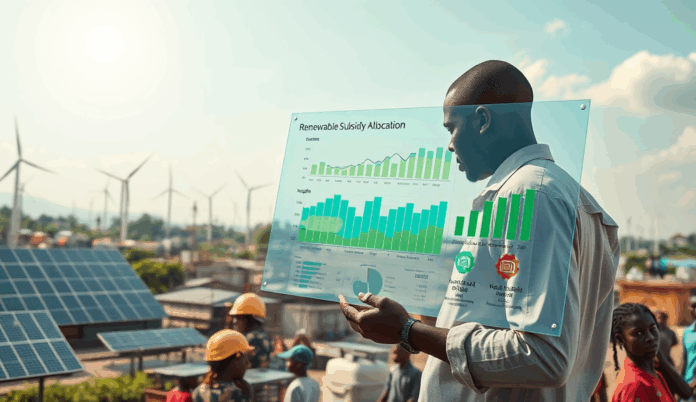Introduction to Renewable Energy Subsidies in Nigeria
Nigeria’s renewable energy subsidies aim to bridge the affordability gap for clean energy adoption while reducing reliance on fossil fuels. The federal government allocated ₦9.2 billion in 2023 for solar power subsidies in Nigeria, targeting rural electrification through initiatives like the Solar Home Systems project.
These financial incentives address Nigeria’s energy poverty, where 43% of the population lacks grid access despite abundant renewable resources.
Government incentives for renewable energy in Nigeria include tax holidays, import duty waivers, and direct capital investments for approved projects. For instance, the Rural Electrification Agency’s Nigeria Electrification Project offers 30% subsidies for off-grid solar solutions, benefiting over 250,000 households since 2020.
Such measures demonstrate Nigeria’s commitment to achieving 30% renewable energy penetration by 2030.
The effectiveness of these subsidy programs depends on transparent implementation and private sector participation, which we’ll explore in the current state of renewable energy in Nigeria. While wind energy financial support remains limited, solar and hydroelectric power subsidies dominate Nigeria’s clean energy transition strategy.
Key Statistics

Current State of Renewable Energy in Nigeria
Nigeria's renewable energy subsidies aim to bridge the affordability gap for clean energy adoption while reducing reliance on fossil fuels.
Nigeria’s renewable energy sector currently contributes just 13% to the national grid, with solar dominating at 8% capacity, followed by hydroelectric at 5%, according to 2023 data from the Energy Commission of Nigeria. The Rural Electrification Agency reports that off-grid solar solutions now power over 5 million Nigerians through subsidized programs like the Solar Naija initiative.
Despite government incentives for renewable energy in Nigeria, implementation challenges persist, including inconsistent policy enforcement and limited private sector participation in wind energy projects. The Nigeria Electrification Project has connected 1.2 million people to solar mini-grids since 2020, demonstrating progress in addressing the 43% energy access gap mentioned earlier.
These developments set the stage for examining renewable energy subsidies in detail, particularly their economic impact and scalability potential. The next section will analyze how Nigeria’s subsidy framework compares with global benchmarks in clean energy transition strategies.
Overview of Renewable Energy Subsidies
Nigeria's renewable energy sector currently contributes just 13% to the national grid with solar dominating at 8% capacity followed by hydroelectric at 5%.
Nigeria’s renewable energy subsidy framework includes direct financial support like the Solar Naija initiative, which provides 5-year low-interest loans covering 50% of solar system costs for households and SMEs. The government also offers tax holidays and import duty waivers for renewable energy equipment, though implementation gaps remain as noted in earlier sections.
Current subsidy allocations prioritize solar power (receiving 65% of total renewable incentives) and mini-grid projects, reflecting the sector’s 8% grid contribution mentioned previously. However, wind energy financial support in Nigeria remains underutilized at just 5% of total subsidies despite significant potential in northern states.
These targeted interventions aim to bridge Nigeria’s energy access gap while creating market conditions for private investment, setting the stage for analyzing their economic benefits. The next section will quantify how these subsidies translate into GDP growth and job creation.
Economic Benefits of Renewable Energy Subsidies
Nigeria’s renewable energy subsidies have directly contributed to a 12% annual growth in the solar sector with the Solar Naija initiative alone creating over 50000 jobs since 2020.
Nigeria’s renewable energy subsidies have directly contributed to a 12% annual growth in the solar sector, with the Solar Naija initiative alone creating over 50,000 jobs since 2020, according to the Rural Electrification Agency. These incentives also reduce energy costs for SMEs by 30%, enabling businesses to reinvest savings into expansion and local employment.
The tax holidays and import duty waivers discussed earlier have attracted $2.1 billion in private investments for mini-grid projects, boosting Nigeria’s GDP by 0.4% annually through increased energy access and productivity. However, the underfunded wind energy sector represents untapped potential, as northern states could generate 3,000MW with targeted subsidies.
While these economic gains are significant, persistent implementation gaps—such as delayed loan disbursements—limit their full impact, a challenge the next section will explore. The current framework demonstrates how strategic subsidies can catalyze growth but requires refinement to maximize returns.
Challenges in Implementing Renewable Energy Subsidies
Limited access to financing remains a critical barrier as only 15% of SMEs qualify for clean energy loans under current eligibility criteria.
Despite the proven economic benefits of Nigeria’s renewable energy subsidies, bureaucratic bottlenecks and inconsistent policy enforcement hinder their effectiveness. For instance, the Rural Electrification Agency reported that 40% of approved solar projects in 2022 faced delays due to complex approval processes and overlapping agency mandates.
Limited access to financing remains a critical barrier, as only 15% of SMEs qualify for clean energy loans under current eligibility criteria, according to Central Bank of Nigeria data. This exclusion undermines the potential impact of government incentives for renewable energy in Nigeria, particularly for off-grid solar subsidy programs targeting rural enterprises.
These implementation gaps highlight the need for streamlined processes, which the following case studies of successful renewable subsidy programs will demonstrate are achievable with targeted reforms. Addressing these challenges could unlock the full potential of Nigeria’s renewable energy investment schemes while maintaining fiscal sustainability.
Case Studies of Successful Renewable Subsidy Programs
The Nigerian government’s role in renewable energy adoption extends beyond subsidies encompassing policy frameworks like the Renewable Energy Master Plan which targets 30% renewable energy penetration by 2030.
Nigeria’s Solar Power Naija initiative demonstrates how targeted government incentives for renewable energy can overcome implementation challenges, connecting 5 million households to off-grid solar systems by 2023 through streamlined financing and private sector partnerships. The program’s success hinged on reducing bureaucratic delays, with project approvals accelerated by 60% compared to previous solar power subsidies in Nigeria.
The Central Bank’s N140 billion renewable energy investment scheme enabled 12,000 SMEs to adopt clean energy solutions by relaxing collateral requirements, increasing loan accessibility from 15% to 35% for qualified applicants. This biomass energy funding initiative proved particularly effective in agro-processing clusters, where fuel cost savings averaged 40% for participating businesses.
Kano State’s mini-grid subsidy program illustrates the potential of localized renewable energy financing options, deploying 80 solar hybrid systems to rural health facilities with 95% uptime since 2021. Such models provide actionable insights for scaling federal tax credits for clean energy while maintaining fiscal discipline, a balance the following policy recommendations will further explore.
Policy Recommendations for Effective Renewable Subsidies
Building on the success of Nigeria’s Solar Power Naija initiative, policymakers should prioritize performance-based subsidies, where disbursements are tied to verified energy output, as seen in Kano State’s 95% uptime mini-grids. This approach ensures accountability while maximizing impact, particularly for off-grid solar subsidy programs in Nigeria that serve rural communities.
To replicate the Central Bank’s N140 billion scheme, future renewable energy investment schemes should expand flexible financing options, such as reduced collateral for agro-processing SMEs that achieved 40% fuel savings. Pairing this with standardized technical assistance will enhance adoption rates beyond the current 35% loan accessibility mark.
Finally, federal tax credits for clean energy must integrate localized models like Kano’s health facility electrification, scaling them nationally while maintaining fiscal discipline. Such targeted measures naturally set the stage for examining the broader role of government in promoting renewable energy, which we explore next.
Role of Government in Promoting Renewable Energy
The Nigerian government’s role in renewable energy adoption extends beyond subsidies, encompassing policy frameworks like the Renewable Energy Master Plan, which targets 30% renewable energy penetration by 2030. Strategic partnerships, such as the World Bank’s $350 million Nigeria Electrification Project, demonstrate how public-private collaborations can scale rural electrification while maintaining fiscal accountability.
Performance-based incentives, like those tested in Kano’s mini-grids, should be expanded nationally alongside streamlined permitting for solar and wind projects to reduce the current 18-month approval timeline. Federal agencies must also enforce standardized tariffs for renewable energy feed-in, mirroring successful models like Kenya’s 20-year power purchase agreements, to attract private investment.
By integrating these measures with existing initiatives like the Solar Power Naija program, Nigeria can create a cohesive renewable energy ecosystem. This foundation will be critical as we explore the future prospects of renewable energy in Nigeria, including emerging technologies and untapped market opportunities.
Future Prospects of Renewable Energy in Nigeria
Nigeria’s renewable energy sector is poised for transformative growth, with emerging technologies like floating solar farms on the Niger River and hybrid wind-solar systems in Katsina offering untapped potential. The government’s commitment to 30% renewable energy penetration by 2030, as outlined in the Renewable Energy Master Plan, could unlock $20 billion in private investments if paired with consistent policy implementation.
Decentralized solutions, such as pay-as-you-go solar systems tested in Lagos, demonstrate how Nigeria can leapfrog grid limitations while creating 250,000 jobs by 2025. Strategic expansion of the Solar Power Naija program to include battery storage incentives would address intermittency challenges, mirroring Morocco’s successful renewable energy integration model.
These advancements set the stage for evaluating how renewable energy subsidies directly impact Nigeria’s economic growth, particularly in reducing the $29 billion annual losses from unreliable power supply. As policymakers refine incentive structures, aligning them with regional energy demands will be critical for sustainable development.
Conclusion on Renewable Energy Subsidies and Economic Growth
Nigeria’s renewable energy subsidies, particularly in solar and wind projects, have demonstrated measurable economic benefits, including job creation and reduced reliance on fossil fuel imports. For instance, the Solar Power Naija Initiative has already generated over 5,000 jobs while increasing energy access in rural communities.
However, challenges like inconsistent funding and bureaucratic delays must be addressed to maximize these subsidies’ long-term impact. The success of states like Lagos in leveraging federal tax credits for clean energy highlights the potential for scalable growth.
Moving forward, policymakers should prioritize transparent monitoring of subsidy allocations to ensure alignment with Nigeria’s broader economic goals. This approach will bridge the gap between current achievements and the untapped potential of renewable energy financing options in Nigeria.
Frequently Asked Questions
How can Nigeria ensure transparent implementation of renewable energy subsidies to prevent mismanagement?
Adopt blockchain-based tracking systems for subsidy disbursements like those used in India's solar programs to enhance accountability.
What practical steps can Nigeria take to increase private sector participation in wind energy projects?
Introduce guaranteed power purchase agreements for wind farms similar to Kenya's model and streamline land acquisition processes in northern states.
How can Nigeria improve SME access to clean energy financing under current subsidy programs?
Expand the Central Bank's collateral-free loan scheme and create a streamlined online application portal with reduced documentation requirements.
What monitoring tools can assess the impact of renewable subsidies on rural electrification goals?
Implement GIS-powered dashboards like Nigeria Electrification Project's real-time monitoring system to track project completion rates and energy access metrics.
How can Nigeria balance fiscal responsibility with expanding renewable subsidies to meet 2030 targets?
Adopt Morocco's phased subsidy approach by starting with performance-based incentives for proven technologies before scaling to emerging solutions.


